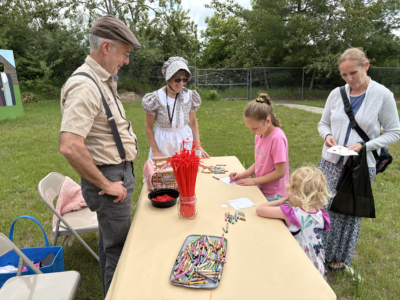‘Maybe they find a little peace’
How yoga helps to ease effects of trauma

News Photo by Julie Riddle Alpena yoga instructor Paige Trisko entices a deep, soothing resonance from a gong, one of the instruments she uses to help students address the effects of trauma through therapeutic yoga.
ALPENA — In a roomful of sound, there was nothing left but to close your eyes, let go of everything, and breathe.
Brass-colored Tibetan singing bowls from Nepal surrounded Paige Allia, her stockinged feet tucked into her knees as she sat cross-legged on the wooden floor. As she slowly circled a heavy stick around the rim of one of the bowls, a deep, rich tone hummed into the small room, filling it to the corners.
In a simple room of her Alpena home, Allia enticed a warm thrumming from a collection of bowls and chimes, the essential ingredients of a sound bath, one of the tools Allia uses in her work as a teacher of therapeutic yoga.
“I just kind of let people feel,” Allia said, coaxing an eerie melody from a hanging gong.
The yoga instructor, who works at Bella Rose Studio and Performance Locker in Alpena in addition to seeing clients in her in-home studio, uses the popular practice to offer healing to people who are coping with the lingering effects of trauma.
A hurtful childhood experience, a divorce, a car crash — trauma of all kinds can affect our bodies more than we realize, Allia said.
Stress has physiological effects that affect breathing, hormone release, even posture, leading to any number of residual physical problems, from a sore neck to digestive troubles to heart disease.
Yoga, known for its slow-motion stretching and breathing exercises, has the potential to offer more than just relaxation, Allia said. When used as an intentionally therapeutic art, it helps people feel safe inside their own body.
Trauma disconnects you, she explained. People who have confronted some impactful hurt often react with a layer of numbness as a form of protection.
“They’re always on the lookout for something to happen,” Allia said, a state that elevates stress hormones and puts the whole body at risk.
Through yoga, the instructor re-teaches people how to breathe and to move in a way that reassures the brain and lets it step away from its flight-or-fight reflexes.
It’s possible to be physically affected by stress without realizing it, she said. Someone who suffers physical injuries in a car crash, for example, may know they need physical therapy to help their body heal but not see their deeper wounds.
Traumatic events can leave a lingering feeling of lack of control or fear of everyday situations, reactions people may not realize until they use yoga to pause, to be still, and to breathe.
The word yoga means connect, hearkening back to imagery of a connecting yoke used in drawing a wagon.
Yoga, focused on the body in a very individual, intimate way, Allia said, “is about learning about yourself – from how you move to meeting your needs to learning how to breathe,” Allia said. “It’s about connecting to yourself, and recognizing that you’re not alone.”
Allia knows firsthand the power of yoga to heal. As a cultural anthropology student doing battle with the stress of a master’s thesis 12 years ago, she took her mom’s advice and attended her first yoga class.
She was instantly hooked. Over 500 hours of professional training later, Allia became a teacher of the practice that helped her past the grief of a divorce and the lingering effects of past sexual abuse.
Therapeutic yoga is in the hands of the client, she said. Her students who have experienced trauma set goals based on their individual needs.
Instead of prescribing a routine, Allia offers options for what happens next — perhaps a stretch, or breathing exercise, or quiet meditation, or a sound bath — and lets the student decide what will still their anxieties.
Sometimes, she said, we avoid what we most need. Students most in need of stillness, quietness, and calm movement may come to her studio in a restless flurry, asking to bend, to stretch, to move.
She works with stress-touched bodies and fear-affected minds at their own pace, helping them be ready to be alone with their thoughts — sometimes a very scary place to be, she said.
“Eventually, over time, maybe they find a little bit of softness,” Allia said. “And maybe they find a little peace.”
CORRECTION: Paige Allia teaches therapeutic yoga. Her name was incorrect in an earlier version of this story.



